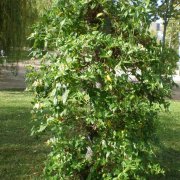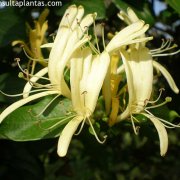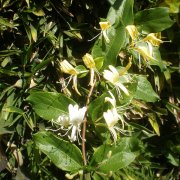Care of the climbing plant Lonicera japonica or Japanese honeysuckle |
|
The genus Lonicera, family Caprifoliaceae, comprises 100 species of shrubs and climbing plants native to the Northern Hemisphere. Some species are: Lonicera japonica, Lonicera implexa, Lonicera etrusca, Lonicera periclymemum, Lonicera caprifolia, Lonicera sempervirens, Lonicera nitida, Lonicera caerulea. Common names: Japanese honeysuckle, Golden-and-silver honeysuckle. This species is native to Korea, Japan and China. They are perennial climbing shrubs that reach 10 meters (32.8 feet) in length. The light green leaves are opposite, have an ovate-oblong shape and have small hairs when young. The flowers are very aromatic, tubular in shape and white (later they turn yellow). They bloom in summer and occasionally in fall. These fast-growing rustic plants are used to cover pergolas, fences, and walls. Japanese honeysuckle needs some kind of support. Lonicera japonica prefers a shaded or semi-shaded exposure, avoiding direct sun in the hottest hours of the day. It prefers cool temperatures; they resist frost. Golden-and-silver honeysuckle can grow in any soil but appreciates that it contains organic matter and is well drained. Planting is done in early spring. Water moderately, waiting for the substrate to dry almost completely. Fertilize with compost, humus or manure in autumn. Prune after flowering to maintain compact size and to control growth because it tends to be invasive. Lonicera japonica can be attacked by fungi if there is excess humidity and sometimes by caterpillars, mealybugs and aphids. Japanese honeysuckle propagates in late autumn from woody cuttings or in summer from semi-woody cuttings. |
Images of the climbing plant Lonicera japonica or Japanese honeysuckle |
Find plants
Lonicera japonica or Japanese honeysuckle | Care and Growing
© 2025 FavThemes




